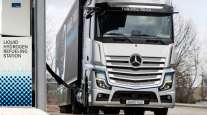Western Star Aims to Boost Market Share With New 4700; Another Model to Come
This story appears in the May 14 print edition of Transport Topics.
LAS VEGAS — Executives at Western Star Trucks, Daimler AG’s North American niche brand, want to boost U.S. heavy-duty market share toward the 3% level from its current neighborhood of 1.2%, hoping that its new 4700 and another model to come will increase sales toward that level.
Western Star will introduce a new highway truck in the next few years to complement the manufacturer’s three current over-the-road models and an off-road vocational truck, General Manager Michael Jackson said here May 7.
He spoke at a promotional campaign for the 4700, which began production in December and is aimed at the “Baby 8” market of smaller heavy-duty trucks (see story, p. 32).
“The new truck will be based on our heritage. It will be a new, aerodynamic, on-highway model,” said Jackson, who added that it will debut more than a year from now, but in fewer than five years.
The 45-year-old truck maker was started in 1967 as a division of White Trucks, with a factory in Kelowna, British Columbia. Daimler Trucks North America bought Western Star from one of its subsequent owners in 2000 and moved production to Portland, Ore.
Although the company’s headquarters is in Fort Mill, S.C., Western Star’s only plant is in Portland.
Western Star is now operating with two shifts a day, during which it cranks out 38 trucks a day, Jackson said. He said the company has seen some mixed signals on business conditions.
Customers in the oil and gas business have been strong buyers lately, but they — along with many others — have been cutting back on orders in recent months, he said.
“We’re assuming this is a temporary slowdown and not a long-term trend,” he said.
Vocational trucks for construction have been an important part of the Western Star market, but recovery for that part of the economy is far from certain.
“We are optimistic that the construction market will bounce back, though we expect it to do so slowly,” Jackson said. “We know that many of the trucks out there are getting very old, and we are seeing operators starting to come in for replacement vehicles.”
In contrast, retail U.S. sales continue to grow, year-over-year, and the company also exports to the Southern Hemisphere, with South America, South Africa, and Australia and New Zealand its best markets.
Freightliner’s heavy-duty U.S. sales dwarf those of Western Star.
Last year, DTNA sold 25 Freightliners for every Western Star, according to data from WardsAuto.com, which showed Freightliner as the largest heavy-duty brand and Western Star as the smallest of the seven U.S. brands.
He said Western Star has about 7% of the Canadian market and that, in terms of total units sold there, often has been a 50-50 split between the countries, but right now, the United States has a small lead in Western Stars purchased.
While there is some overlap in their production, Jackson emphasized the differences. Most Western Stars are sold to very small fleets, with 64% of its vehicles going to operators with one to three trucks.
An additional 27% of trucks sold go to fleets with fewer than 100 trucks, according to company statistics. In contrast, Freightliner sells a majority of its trucks in large batches to medium- and large-size fleets.
Freightliner has a strong presence in the Class 6 and 7 medium-duty market, but Jackson said Western Star has no plans to enter that market.
Jackson reports directly to Martin Daum, DTNA’s chief executive officer, who has been an enthusiastic supporter of Western Star, which he once called a “shining star of profitability.”
DTNA closed its third brand, Sterling Trucks, in 2009. That company made basic trucks with lower profit margins. Western Star’s approach to the market, Jackson said, is premium, customized, rugged trucks for the toughest operating conditions.
The company’s top five market segments, Jackson said, are mining, logging, oil and gas, specialty and heavy-haul, and vehicle transport. He would like to improve sales to construction companies and to state and local governments, with the latter offering some significant challenges.
“Some municipalities have as their overriding concern, whatever is cheapest,” Jackson said, describing a type of business that is contrary to the company’s usual pursuits. “Others are interested in aluminum versus steel, emissions controls and all sorts of different themes. If there is a very demanding spec’ for us to meet, that would work well for us,” he added.
Freight hauling is one of the major applications for the company’s vehicles, but they also do a lot of vocational work. While 60% of sales are highway tractors, the other 40% are heavy-duty straight trucks. Detroit Diesel Corp., another DTNA subsidiary, supplies about 60% of engines, whereas Cummins Inc. makes about 40% of them.
Sixty percent of production comes in the day-cab format, and 40% are built with sleeper berths.




